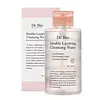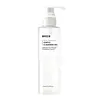What's inside
What's inside
 Key Ingredients
Key Ingredients

 Benefits
Benefits

 Concerns
Concerns

 Ingredients Side-by-side
Ingredients Side-by-side

Water
Skin ConditioningIsododecane
EmollientIsopropyl Palmitate
EmollientDipropylene Glycol
HumectantCetyl Ethylhexanoate
Emollient1,2-Hexanediol
Skin ConditioningHydrogenated Poly(C6-14 Olefin)
EmollientSodium Chloride
MaskingHydroxyacetophenone
AntioxidantSodium Citrate
BufferingDisodium EDTA
Centella Asiatica Extract
CleansingEpilobium Angustifolium Flower/Leaf/Stem Extract
Skin ConditioningSaponaria Officinalis Leaf Extract
AntimicrobialSapindus Trifoliatus Fruit Extract
Skin ConditioningHydrolyzed Gardenia Florida Extract
Antioxidant4-Terpineol
MaskingHibiscus Sabdariffa Flower Extract
Skin ConditioningNelumbium Speciosum Flower Extract
Skin ConditioningNymphaea Alba Flower Extract
Skin ConditioningPrunus Serrulata Flower Extract
Skin ConditioningMaltodextrin
AbsorbentButylene Glycol
HumectantLactobacillus Ferment Lysate
Skin ConditioningBiosaccharide Gum-4
Skin ConditioningXanthan Gum
EmulsifyingEthylhexylglycerin
Skin ConditioningCeramide NP
Skin ConditioningAsiaticoside
AntioxidantMadecassoside
AntioxidantAsiatic Acid
Skin ConditioningMadecassic Acid
Skin ConditioningWater, Isododecane, Isopropyl Palmitate, Dipropylene Glycol, Cetyl Ethylhexanoate, 1,2-Hexanediol, Hydrogenated Poly(C6-14 Olefin), Sodium Chloride, Hydroxyacetophenone, Sodium Citrate, Disodium EDTA, Centella Asiatica Extract, Epilobium Angustifolium Flower/Leaf/Stem Extract, Saponaria Officinalis Leaf Extract, Sapindus Trifoliatus Fruit Extract, Hydrolyzed Gardenia Florida Extract, 4-Terpineol, Hibiscus Sabdariffa Flower Extract, Nelumbium Speciosum Flower Extract, Nymphaea Alba Flower Extract, Prunus Serrulata Flower Extract, Maltodextrin, Butylene Glycol, Lactobacillus Ferment Lysate, Biosaccharide Gum-4, Xanthan Gum, Ethylhexylglycerin, Ceramide NP, Asiaticoside, Madecassoside, Asiatic Acid, Madecassic Acid
Water
Skin ConditioningGlycerin
HumectantSodium Cocoyl Alaninate
Lauryl Hydroxysultaine
CleansingLauryl Glucoside
CleansingQuillaja Saponaria Bark Extract
CleansingSodium Hyaluronate
HumectantHydrolyzed Hyaluronic Acid
HumectantHyaluronic Acid
HumectantAcrylates/C10-30 Alkyl Acrylate Crosspolymer
Emulsion StabilisingCoco-Betaine
Cleansing1,2-Hexanediol
Skin ConditioningCaprylyl Glycol
EmollientCoco-Glucoside
CleansingSodium Cocoyl Isethionate
CleansingSodium Myristoyl Glutamate
CleansingProtease
ExfoliatingButylene Glycol
HumectantPropanediol
SolventBenzyl Glycol
SolventHydrolyzed Glycosaminoglycans
HumectantSodium Hyaluronate Crosspolymer
HumectantEthylhexylglycerin
Skin ConditioningHydroxypropyltrimonium Hyaluronate
Sodium Acetylated Hyaluronate
HumectantCitric Acid
BufferingSodium Chloride
MaskingWater, Glycerin, Sodium Cocoyl Alaninate, Lauryl Hydroxysultaine, Lauryl Glucoside, Quillaja Saponaria Bark Extract, Sodium Hyaluronate, Hydrolyzed Hyaluronic Acid, Hyaluronic Acid, Acrylates/C10-30 Alkyl Acrylate Crosspolymer, Coco-Betaine, 1,2-Hexanediol, Caprylyl Glycol, Coco-Glucoside, Sodium Cocoyl Isethionate, Sodium Myristoyl Glutamate, Protease, Butylene Glycol, Propanediol, Benzyl Glycol, Hydrolyzed Glycosaminoglycans, Sodium Hyaluronate Crosspolymer, Ethylhexylglycerin, Hydroxypropyltrimonium Hyaluronate, Sodium Acetylated Hyaluronate, Citric Acid, Sodium Chloride
 Reviews
Reviews

Ingredients Explained
These ingredients are found in both products.
Ingredients higher up in an ingredient list are typically present in a larger amount.
1,2-Hexanediol is a synthetic liquid and another multi-functional powerhouse.
It is a:
- Humectant, drawing moisture into the skin
- Emollient, helping to soften skin
- Solvent, dispersing and stabilizing formulas
- Preservative booster, enhancing the antimicrobial activity of other preservatives
Butylene Glycol (or BG) is used within cosmetic products for a few different reasons:
Overall, Butylene Glycol is a safe and well-rounded ingredient that works well with other ingredients.
Though this ingredient works well with most skin types, some people with sensitive skin may experience a reaction such as allergic rashes, closed comedones, or itchiness.
Learn more about Butylene GlycolEthylhexylglycerin (we can't pronounce this either) is commonly used as a preservative and skin softener. It is derived from glyceryl.
You might see Ethylhexylglycerin often paired with other preservatives such as phenoxyethanol. Ethylhexylglycerin has been found to increase the effectiveness of these other preservatives.
Chances are, you eat sodium chloride every day. Sodium Chloride is also known as table salt.
This ingredient has many purposes in skincare: thickener, emulsifier, and exfoliator.
You'll most likely find this ingredient in cleansers where it is used to create a gel-like texture. As an emulsifier, it also prevents ingredients from separating.
There is much debate on whether this ingredient is comedogenic. The short answer - comedogenic ratings don't tell the whole story. Learn more about comegodenic ratings here.
The concensus about this ingredient causing acne seems to be divided. Research is needed to understand if this ingredient does cause acne.
Scrubs may use salt as the primary exfoliating ingredient.
Learn more about Sodium ChlorideWater. It's the most common cosmetic ingredient of all. You'll usually see it at the top of ingredient lists, meaning that it makes up the largest part of the product.
So why is it so popular? Water most often acts as a solvent - this means that it helps dissolve other ingredients into the formulation.
You'll also recognize water as that liquid we all need to stay alive. If you see this, drink a glass of water. Stay hydrated!
Learn more about Water